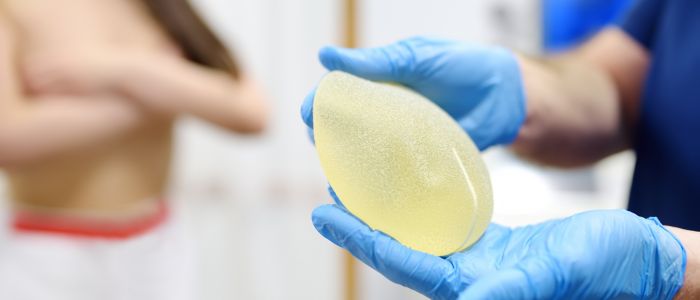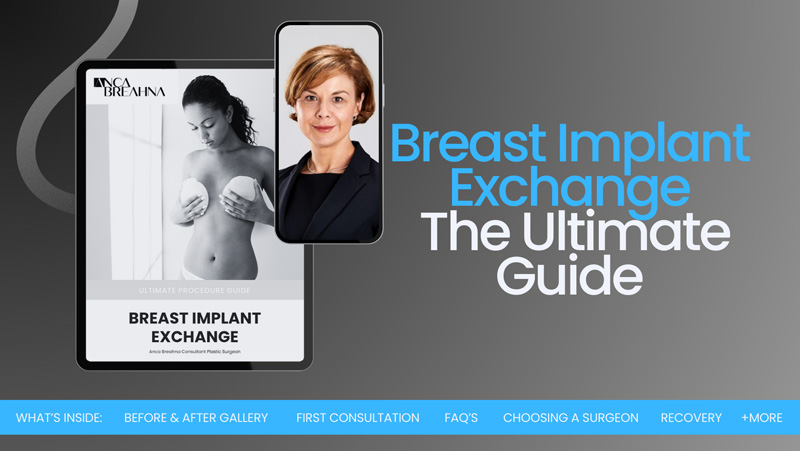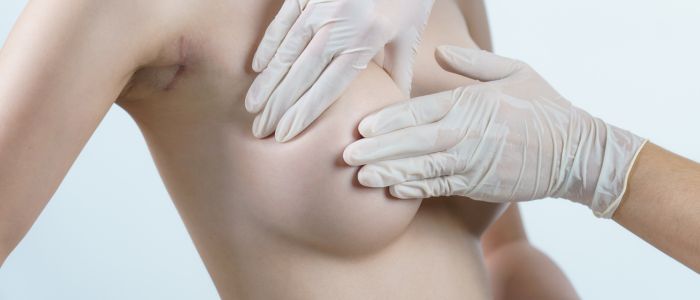
Breast Implant Red Flags: What to Watch For
Breast implants, much like any other medical devices, have a finite lifespan. While they can offer years of enhanced aesthetics and personal satisfaction, it’s important to understand that they aren’t meant to last forever. Knowing when it’s time to replace your breast implants can help you maintain your health and desired appearance.
In this blog, Consultant Plastic Surgeon Anca Breahna will help you understand the signs that indicate it’s time to replace your breast implants, the importance of regular check-ups, and what to expect during the replacement process.
Take our Plastic Surgery Quiz to find out if you’d be a good candidate for cosmetic surgery.
Typical Lifespan of Breast Implants
Breast implants are not designed to last a lifetime. While they can provide long-lasting results, it’s essential to understand that they will eventually need to be replaced. The typical lifespan of breast implants varies depending on factors such as the type of implant, your body’s healing response, and your overall health. On average, breast implants can last between 10 to 20 years before requiring replacement.
To ensure the longevity and safety of your breast implants, regular check-ups with Anca are crucial. These appointments allow Anca to assess the condition of your implants, monitor for any potential complications, and provide guidance on when a replacement may be necessary. By staying proactive and attending these check-ups, you can catch any issues early on.
Common Signs Your Breast Implants May Need Replacing
Changes in Size or Shape
One of the most noticeable signs that your breast implants may need replacing is a change in their size or shape. If you observe that one or both breasts have suddenly become larger, smaller, or have shifted in position, it could indicate an issue with your implants. These changes may be due to factors such as implant rupture, capsular contracture, or natural changes in your body over time. If you notice any significant alterations, it’s essential to consult Anca promptly.
Persistent Pain or Discomfort
While some discomfort is normal immediately after breast augmentation surgery, persistent pain or discomfort that develops later on should not be ignored. If you experience chronic pain, soreness, or tenderness in your breasts or the surrounding areas, it may be a sign that your implants are causing issues. Pain can be a symptom of capsular contracture, implant rupture, or other complications that require medical attention. Don’t hesitate to discuss any discomfort with Anca to determine if implant replacement is necessary.
Visible Wrinkling or Rippling
Another visual indication that your breast implants may need replacing is the appearance of visible wrinkling or rippling. This occurs when the implant shell becomes folded or creased, creating a wavy or rippled appearance on the surface of the breast. Wrinkling and rippling are more common with saline implants and in patients with thin breast tissue. If the rippling becomes noticeable or bothersome, Anca may recommend replacing the implants or exploring alternative options to achieve a smoother, more natural-looking result.
Download Anca’s Breast Implant Exchange Guide

Detecting Implant Rupture or Leakage
Symptoms of Saline Implant Rupture
Saline implants are filled with a sterile saltwater solution. If a saline implant ruptures, the saltwater is safely absorbed by the body, but the affected breast will quickly deflate, resulting in a noticeable change in size and shape. You may experience a sudden decrease in breast volume, asymmetry between the breasts, or a feeling of “emptiness” in the affected breast. If you suspect a saline implant rupture, contact Anca immediately to discuss replacement options.
Symptoms of Silicone Implant Rupture
Silicone implants are filled with a cohesive silicone gel. Unlike saline implants, silicone implant ruptures can be harder to detect as the gel tends to remain within the implant shell or the surrounding scar tissue. This is known as a “silent rupture.” Symptoms of a silicone implant rupture may include changes in breast shape, firmness, or sensation. In some cases, you may feel a burning sensation, numbness, or tingling in the affected breast. Regular check-ups and imaging tests are essential for monitoring the integrity of silicone implants.
For patients with silicone implants, the recommendation is undergoing MRI scans every two to three years to check for silent ruptures. MRI scans are the most reliable method for detecting silicone implant ruptures, as they provide detailed images of the implants and surrounding tissues. If a rupture is suspected or confirmed through an MRI, Anca will guide you through the process of implant removal and replacement.
What It Is and How to Recognise Capsular Contracture
Capsular contracture is a complication that can occur after breast augmentation surgery. It happens when the scar tissue that naturally forms around the implant begins to tighten and constrict, squeezing the implant and causing various symptoms. Capsular contracture can develop months or even years after the initial surgery and is one of the most common reasons for breast implant replacement.
Signs and Symptoms
The primary signs and symptoms of capsular contracture include:
- Firmness or hardness in the affected breast
- Pain or discomfort, especially when touched or pressed
- Changes in breast shape, such as becoming more round or “ball-like”
- Asymmetry between the breasts
- Upward displacement of the implant
- Visible distortion or rippling of the breast
If you experience any of these symptoms, it’s important to consult Anca for an evaluation. She will assess the severity of the capsular contracture and recommend the appropriate treatment plan.
The treatment for capsular contracture depends on the severity of the condition. In mild cases, massage techniques or medication may be prescribed to help soften the scar tissue. However, in more advanced cases, surgical intervention is often necessary. This may involve a capsulectomy, where Anca removes the hardened scar tissue, or a capsulotomy, where Anca releases the constricted scar tissue. In most cases, the affected implant will also be replaced during the procedure to ensure the best possible outcome.
Replacing Breast Implants Due to Changes in the Body and Lifestyle
Weight Fluctuations and Their Impact
Significant weight changes can affect the appearance and feel of your breast implants. If you experience substantial weight gain or loss after your breast augmentation, you may notice changes in the size, shape, and position of your breasts. The skin and tissues surrounding the implants may stretch or sag, leading to an unsatisfactory appearance. In some cases, these changes may warrant a breast implant replacement or a combination of procedures, such as a breast lift, to restore a more youthful and balanced look.
Pregnancy and Breastfeeding Considerations
Pregnancy and breastfeeding can also impact the appearance of your breast implants. During pregnancy, your breasts may enlarge and change shape due to hormonal fluctuations and the preparation for milk production. After pregnancy and breastfeeding, your breasts may lose volume and appear deflated or saggy. While breast implants do not typically interfere with breastfeeding, the changes in breast tissue can affect the overall aesthetic outcome. If you are dissatisfied with the appearance of your breasts after pregnancy and breastfeeding, you may consider a breast implant replacement or a mommy makeover to address your concerns.
Ageing and Breast Implant Compatibility
As you age, your body undergoes natural changes that can affect the appearance of your breast implants. The skin loses elasticity, and the breasts may begin to sag or droop over time. This process can be accelerated by factors such as genetics, sun exposure, and lifestyle habits. As a result, your breast implants may no longer sit in the desired position or provide the same level of enhancement as they once did. If you feel that your implants are no longer compatible with your body due to ageing, you may consider a breast implant replacement or a combination of procedures to achieve a more youthful and harmonious look.
Removing Breast Implants – Breast Implant Illness (BII)
Breast Implant Illness (BII) is a term used to describe a range of systemic symptoms that some women with breast implants may experience. While the exact cause of BII is not yet fully understood, it is believed to be related to an immune system response to the implants. BII is not an official medical diagnosis, but many women have reported similar symptoms that they attribute to their breast implants.
The symptoms of BII can vary from person to person, but some of the most commonly reported ones include:
- Fatigue and chronic tiredness
- Brain fog and memory issues
- Joint and muscle pain
- Hair loss and skin rashes
- Digestive problems and gastrointestinal issues
- Headaches and migraines
- Anxiety and depression
If you experience a combination of these symptoms and suspect that your breast implants may be the cause, it’s important to consult with Anca who is knowledgeable about BII.
Overview of the Breast Implant Replacement Procedure
When it’s time to replace your breast implants, the procedure is similar to your initial breast augmentation surgery. Anca will make an incision, typically along the same line as your original scar, to access the implant pocket. She will then remove the old implants and any surrounding scar tissue, if necessary. If you are experiencing capsular contracture, Anca may perform a capsulectomy or capsulotomy to release or remove the constricted scar tissue. Once the pocket is prepared, Anca will insert the new implants and close the incisions with sutures.
After your breast implant replacement surgery, you can expect a recovery period similar to that of your initial augmentation. You may experience some swelling, bruising, and discomfort in the days following the procedure. Anca will provide you with detailed post-operative instructions, including how to care for your incisions, when to wear a supportive bra, and any activity restrictions. It’s essential to follow these instructions carefully to ensure a smooth and successful recovery. Most patients can return to work and resume normal activities within a week or two, but it’s important to listen to your body and not push yourself too hard too soon.
As with any surgical procedure, breast implant replacement carries some risks and potential complications. These may include infection, bleeding, haematoma, seroma, implant malposition, and changes in nipple sensation. Anca will discuss these risks with you in detail before your surgery and take every precaution to minimise their occurrence. It’s important to be aware of these potential complications and to contact Anca immediately if you experience any concerning symptoms or signs of infection, such as fever, redness, or excessive swelling.
FAQs about Breast Implant Replacement Surgery
How long does the breast implant replacement surgery take?
- Breast implant replacement surgery typically takes between 1 to 3 hours, depending on the complexity of the procedure and whether additional work, such as removing scar tissue or performing a breast lift, is needed. Anca will provide a more precise timeframe based on your specific situation.
What type of anaesthesia is used during implant replacement surgery?
- Most breast implant replacement surgeries are performed under general anaesthesia, meaning you will be asleep and not feel any pain during the procedure. In some cases, local anaesthesia with sedation may be used, depending on the extent of the surgery and patient preference.
Are there different types of implants available for replacement?
- Yes, there are various types of implants available for replacement, including saline, silicone gel, and structured saline implants. Each type has its own advantages and considerations. Anca can help you choose the best option based on your personal goals and body type.
How should I prepare for breast implant replacement surgery?
- Preparation for breast implant replacement surgery involves several steps, such as avoiding certain medications that can increase bleeding, stopping smoking, and arranging for someone to drive you home after the procedure. Anca will provide a detailed list of preoperative instructions to ensure you are well-prepared.
What are my options if I choose not to replace my implants?
- If you decide not to replace your implants, you have the option to remove them entirely without replacement. This can be combined with a breast lift to maintain an aesthetically pleasing shape. Discussing your options with Anca will help you understand the potential outcomes and make an informed decision that aligns with your goals.
Further Reading about Breast Implants Surgery with Consultant Plastic Surgeon Anca Breahna
-
- Read more about Breast Implant Illness – BII Update 2024
- Read more about Preparing for Breast Implant Removal Surgery
- Read more about Recovery after Breast Implant Removal Surgery
- Read more about Removal and Replacement of PIP Breast Implants
- Read more about How Long Do Breast Implants Last?
- Read more about Top Cosmetic Surgery Trends for Menopausal Women
- Read more about How Can You Tell if You Have a Ruptured Breast Implant?
- Read more about When is a Good Time to Get Breast Implants?
Medical References about Implant Replacement
- Breast Implant Removal: What to Expect, Surgery & Recovery – Cleveland Clinic
- Capsulectomy: Surgery to Soften Breast Implants – WebMD
- Do I need to change my breast implants every 10 years? – American Society of Plastic Surgeons
- Breast Implant Illness (BII): What It Is, Symptoms & Treatment – Cleveland Clinic
- What Is Breast Implant Illness? – WebMD


 Ms Anca Breahna, PhD, MSc, FEBOPRAS, FRCS (Plast) is a highly regarded Consultant Plastic Surgeon specialising in the field of Aesthetic and Reconstructive Plastic Surgery. Anca performs a range of
Ms Anca Breahna, PhD, MSc, FEBOPRAS, FRCS (Plast) is a highly regarded Consultant Plastic Surgeon specialising in the field of Aesthetic and Reconstructive Plastic Surgery. Anca performs a range of 